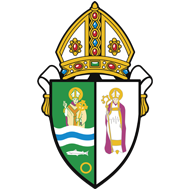The Diocese of Glasgow and Galloway is a union of two of the oldest dioceses in Scotland.
The Diocese covers the counties of Wigtonshire, Kirkcudbright and Dumfriesshire (the ancient Diocese of Galloway) and of Ayrshire, Lanarkshire, Renfrewshire, Dunbartonshire and West Stirlingshire south of the River Forth (the ancient Diocese of Glasgow).
The Diocese of Glasgow was founded in the sixth century by Saint Mungo, also known as Saint Kentigern, and patron saint of Glasgow. In fact, however, there were bishops in the area before him, such as Saint Kessog, whose death is dated circa 520. Indeed, Tertullian, one of the Fathers of the Church, leads us to believe that there were Christians in the area as early as AD 210. From Saint Patrick there is firm evidence of the area being Christian in the mid-fifth century.
The Diocese of Galloway, also known as ‘Candida Casa’ or Whithorn, meaning ‘White House’, is thought to have been founded by Saint Ninian in the fifth century (Saint Ninian’s death is dated to 497). Saint Ninian’s Cave and Chapel in Whithorn remain popular sites of Christian pilgrimage.
The Saints Mungo and Ninian are respectively depicted on the left and right sides of the Diocesan shield.
The Reformation
On 9 January 1492, the Bishopric of Glasgow was raised in rank to be an Archbishopric. During the Scottish Reformation, the heritage and jurisdiction of the church passed into the hands of Church of Scotland. However, the small Scottish Episcopal Church continued the line of bishops of both dioceses, even though, in the 16th century, many of them held the office in title alone.
In 1697, the Diocese of Galloway was united with the Diocese of Edinburgh, and in 1708 the line of Archbishops of Glasgow fell vacant. At that point episcopacy was abolished in the Church of Scotland and Episcopalians separated from the State church. The penal period in the 18th century, when the Episcopal Church was outlawed because of its adherence to the Stuart cause, was a low period for both Dioceses.
The line was revived with the appointment of Alexander Duncan in 1731 as Bishop, rather than Archbishop, of Glasgow. However, when Duncan died two years after his appointment as bishop, the see fell vacant once more. In 1787, William Abernethy Drummond became Bishop of Edinburgh and Galloway and Bishop of Brechin in a temporary personal union of the dioceses.
To this he added the then vacant see of Glasgow in union with Edinburgh and Galloway. Within a year, Drummond gave way to John Strachan as the newly appointed Bishop of Brechin, and, in 1805, resigned from the united see of Edinburgh and Galloway (to Daniel Sandford) to focus on ministry in Glasgow. Drummond continued as Bishop of Glasgow until his death in 1809, when the see was reunited with Edinburgh and Galloway.
First Bishop of Glasgow & Galloway
In 1837, James Walker, bishop of the triple see and Primus, gave way to Michael Russell to be the first modern Bishop of Glasgow and Galloway. In 1878, the Roman Catholic Church re-established the Archdiocese of Glasgow and Diocese of Galloway in its modern structures. In 1888, the counties of Selkirkshire, Peeblesshire and Roxburghshire, which were historically part of the Diocese of Galloway, were transferred from the Episcopalian Diocese of Glasgow and Galloway back to Edinburgh.
Today, the years of decline which marked the second half of the 20th century appear to be behind us. Numbers have stabilised, with several congregations reporting growth. Giving is increasing and there is a marked development in lay involvement in the life and running of the Diocese.
The Rt Rev Kevin Pearson is our Bishop, due to the COVID-19 pandemic and lockdown and Scotland, he was installed by deed from the College of Bishops as the 15th Bishop of the United Diocese on the 1st July 2020.
Companion Dioceses
The Diocese of Glasgow and Galloway has companion links with the Diocese of Byumba, of the Province of the Episcopal Church of Rwanda, and the Diocese of Kentucky, of the Episcopal Church of the United States.
